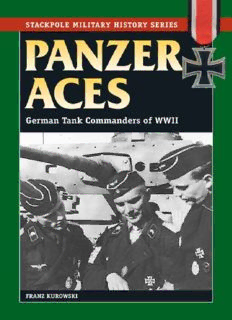
Panzer aces : German tank commanders of World War II PDF
Preview Panzer aces : German tank commanders of World War II
Copyright © 1992 by J. J. Fedorowicz Publishing, Inc. Published in 2004 by STACKPOLE BOOKS 5067 Ritter Road Mechanicsburg, PA 17055 <http://www.stackpolebooks.com/> All rights reserved, including the right to reproduce this book or portions thereof in any form or by any means, electronic or mechanical, including photocopying, recording, or by any information storage and retrieval system, without permission in writing from the publisher. All inquiries should be addressed to J. J. Fedorowicz Publishing, Inc., 104 Browning Boulevard, Winnipeg, MB, R3K 0L7, Canada. www.jjfpub.mb.ca Printed in the United States of America 10 9 8 7 6 5 4 3 FIRST EDITION Library of Congress Cataloging-in-Publication Data Kurowski, Franz. Panzer aces : German tank commanders of World War II / Franz Kurowski ; translated by David Johnston.— 1st ed. p. cm. Originally published: New York : Ballantine Books, 2002. Includes index. ISBN 0-8117-3173-1 1. World War, 1939–1945—Tank warfare. 2. World War, 1939–1945— Germany. 3. Tanks (Military science)—History. 4. Tank warfare—History. 5. Soldiers—Germany—Biography. I. Title: German tank commanders in World War II. II. Title. D793.K86 2004 D793.K86 2004 940.54’21’092243—dc22 2004005895 ISBN: 978-0-8117-3173-7 eISBN: 978-0-8117-4845-2 Table of Contents Introduction Chapter 1: Franz Bäke Chapter 2: Hermann Bix Chapter 3: Rudolf von Ribbentrop Chapter 4: Hans Bölter Chapter 5: Michael Wittmann Chapter 6: Albert Ernst Chapter 7: The Panzer Forces of World War II Appendix Index Introduction The tracked armored fighting vehicle, or tank, was first used in action by the British Army during the Battle of the Somme in July 1916. The British hoped that the new weapon would enable them to break the stalemate of trench warfare. From the time of their introduction, however, there raged a heated debate as to how tanks should to be used—as weapons to escort the infantry or as an independent weapon capable of breaking through the enemy’s fixed defenses. For the Germans, the appearance of the tank came as a tremendous shock and, despite their best efforts, they lagged well behind the Allies in tank development for the remainder of the war. The tank hadn’t played a particularly large role in Germany’s defeat, but German soldiers who had experienced a tank attack were convinced otherwise. The Treaty of Versailles denied Germany the right to build or buy tanks, but the leaders of its post-war army, the Reichswehr, were determined to pursue the development of the new weapon. In their view the lack of tanks had been one of the shortcomings of the Imperial Army during the First World War. Franz Bäke. CHAPTER 1 Franz Bäke WITH THE 6TH PANZER DIVISION IN THE EAST AND WEST The French Campaign (Part I) On 30 January 1940, the 6th Panzer Division, which had been formed from the 1st Light Division, left its garrisons in Germany. The division was commanded by Brigadier General Kempf, one of the pioneers of Germany’s panzer arm. By 2 February the division had assembled in the Euskirchen area. The division headquarters was established in Münstereifel. In the west, German and French forces still faced each other across the frontier. The French promise of help to the Poles, which was to see French forces attack Germany no later than the beginning of the second week after a German attack on Poland, had proved to be a pipe dream. France missed its opportunity to simply overrun Germany’s weakly defended western frontier and end the war in 1939. When Britain and France declared war, Germany did not have a single panzer division in the west. With the return of Germany’s six armored divisions from Poland, any chance of a quick Allied victory disappeared for good. The core of the new 6th Panzer Division was provided by the 65th Panzer Battalion, commanded by Major Thomas. This battalion, which had been part of the 1st Light Division, was joined by the two battalions of the 11th Panzer Regiment, which was commanded by Col. Wilhelm Phillips. The two battalions were commanded by Major Stephan and Major Koll. The period of quiet on the Western Front allowed the newly formed division to carry out regimental exercises starting on 18 October 1939. On 1 March 1940 the 6th Panzer Division was moved into the Wester Woods, where one week later it was incorporated into the XXXXI Army Corps under General of Armored Troops Hans-Georg Reinhardt. Also included in the corps
Description: